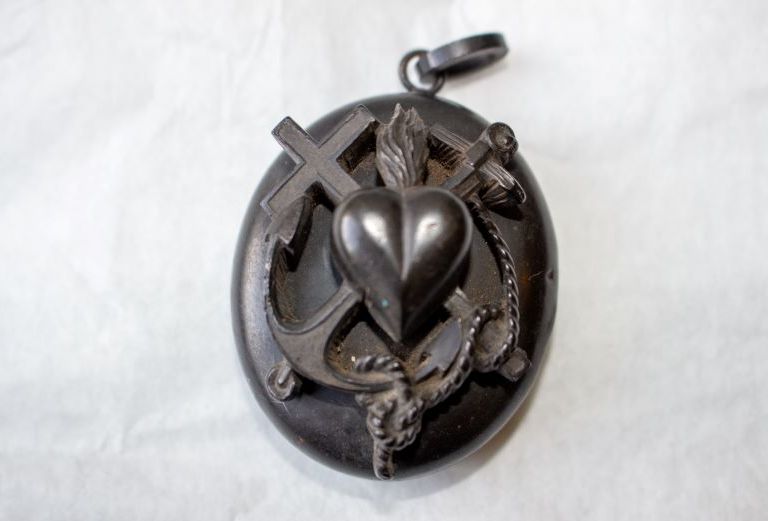
Antia Dona, conservation assistant
In this Halloween week, when the veil between the living and the dead is at its thinnest point, I thought it could be a good time to talk about some of the objects in our collection that commemorate the dead. In particular a favourite of mine, Victorian mourning jewellery.
In the museum, tucked away safely in the store, we have several examples of these mementos, used by the Victorians to remember their loved ones who sadly passed away. But they weren’t the first ones to do it. Relics of the deceased had been preserved, venerated and used as fashion accessories since prehistoric times, gaining more popularity in the medieval period with saints’ bones and pieces of the cross conserved in reliquaries and pendants. But it was the Georgians and the Victorians who took the trend to new levels, mass producing brooches and pendants in which to store the hair and photos of the loved ones.
Human hair does not decay so it was considered sentimental, as you will keep a part of your loved one with you always, as well as fashionable. Normally mourning jewellery would contain a lock or braid of hair, or intricate decorative details could be made using hair.
Another key element of Victorian jewellery was jet. Jet is a gemstone formed from decaying wood which has been under extreme pressure. It’s a coal-like substance, and the jet used in Victorian jewellery is generally 182 million years old. Jet is only found in certain locations worldwide, and Whitby and its beaches is main source of jet in the UK. A particular reason why I feel a connection this jewellery is that another location where jet can be found is in Galicia, the area of Spain where I am from; Santiago the Compostela in Galicia is the third pilgrimage site of Catholicism, and a major producer of jet jewellery. Jet jewellery was widely popular in the Victorian era, especially when Queen Victoria wore it following the death of Prince Albert in 1861.
We have several examples of mourning jewellery which came to our collection via Fulham Palace volunteer Vernon Burgess. They were collected by his grandmother in her antique shop at the West End of London.
Let us see some of them in more detail:

These pendants would normally have symbolic elements and designs, the meaning of these designs would have been widely known at the time, but now many of us wouldn’t know the meaning behind this choice of symbols. In this pendant we have several symbols, the cross, anchor and hearth. The cross is a symbol of faith, the anchor of hope and the heart is there as a symbol of love and charity. Most pendants like this one were lockets, and inside this one is hair. It is made of jet, most likely from Whitby.

We have several examples of locks of hairs or intricate designs made of hair in some of the mourning objects of our collection, some even have the photo of the person who passed away and is being remembered with the pendant.

Another common style of Victorian mourning jewellery is hair mourning brooches like the one below, which became a standard style during the early and mid-19th century. The one in our collection has an ornate hair design in its centre and is surrounded by black enamel, which signifies death, and gold Gothic lettering with the inscription: ‘In Memory Of’. Note also the beautiful acanthus design around the edge, very much in vogue at the time of the Gothic revival. We have to think that these brooches have a double function, as a memento and as a decorative objects, and were worn in the top layer of clothing thus presenting the mourning sentiment to the whole world.
By the turn of the 19th century this style of brooch and other mourning jewellery had gone out of fashion. Instead of tokens of death, sentimental jewellery is now worn by friends and lovers who are still alive rather than dead.
